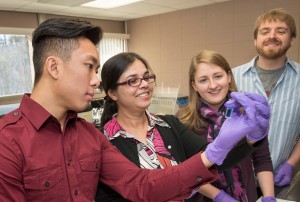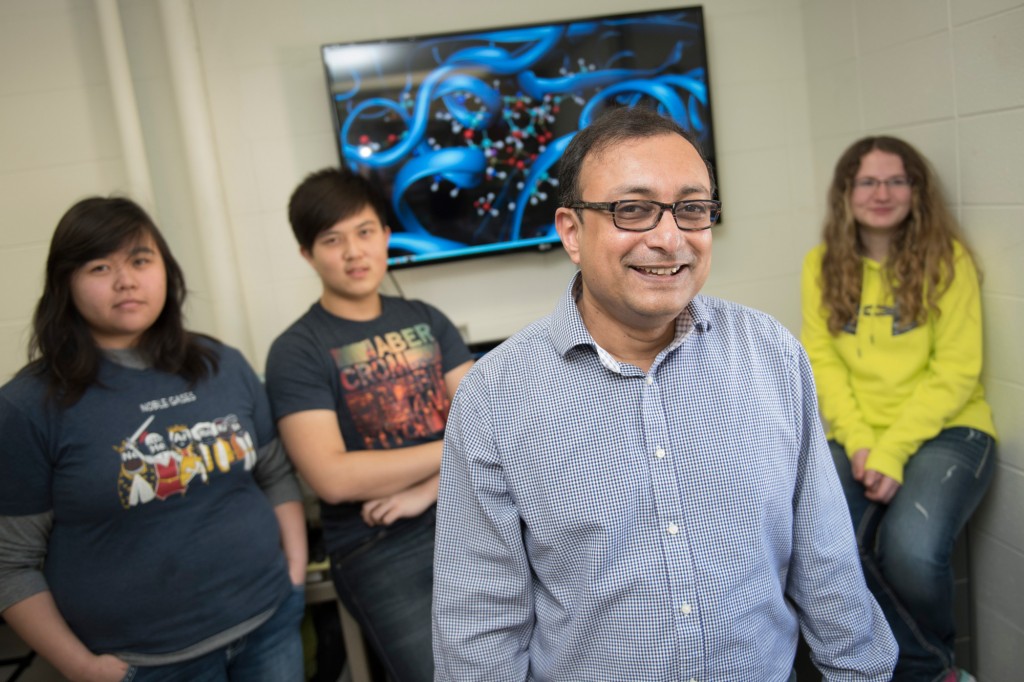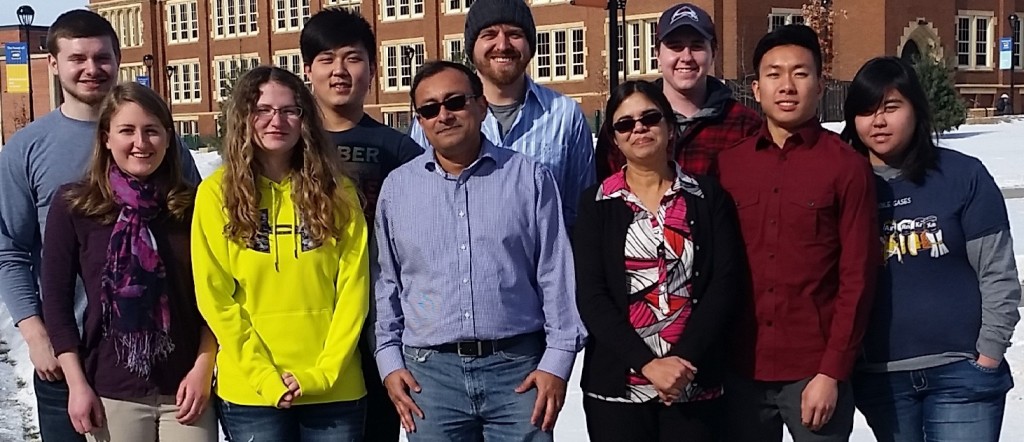
UW-Eau Claire chemistry research students working with Dr. Sanchita Hati. From left: An Nam Hodac, Dr. Sanchita Hati, Lauren Adams and Ryan Andrews.
A prestigious grant and an innovative teaching strategy by a pair of UW-Eau Claire chemistry professors will help increase the number of Blugolds who will graduate with real-world research experience.
Dr. Sanchita Hati, associate professor of chemistry, and Dr. Sudeep Bhattacharyay, assistant professor of chemistry, received a $337,000, three-year grant from the National Institutes of Health Academic Research Enhancement Award Program to support their research.
While the preliminary groundwork for the research will be performed by a core research team, once standardized, the routine work will be conducted by students enrolled in senior-level chemistry classes.
“The integration of research into the chemistry curriculum is a cost-effective approach for providing high-impact learning experiences to many students,” Hati said. “Through the in-class research opportunity, students not only learn new skills to solve original scientific problems but also acquire verbal and written skills to communicate their results to the scientific community.”
Chemistry faculty have collaborated on research with undergraduate students for decades, but only recently have faculty begun redesigning their courses to include authentic research within the curriculum.
“The project will provide high-impact learning experiences to many more undergraduates,”

Dr. Sudeep Bhattacharyay (front) with UW-Eau Claire chemistry research students: (from left) Tiffany Huynh, Huakun Hu, and Clorice Reinhardt
Bhattacharyay said of including both a core research team and chemistry classes in the project. “Our goal is to engage more students by embedding authentic research into chemistry lecture and lab courses.”
The NIH grant will support the research team’s work to study the fundamental question of enzymology: how protein dynamics impact their function.
“This is a new project in which a combined theoretical and experimental study will be carried out to understand the interplay of protein dynamics and function,” Bhattacharyay said.
The researchers are studying a particular family of proteins known as aminoacyl-tRNA synthetases, which are crucial for the synthesis of all proteins in a living organism.
Proteins are large molecules and have versatile chemical and physical roles in nearly all biological processes. They are not static, but rather flexible and dynamic in nature.
In the presence of certain environmental stimuli, they even undergo conformational changes, or “dancing” from one conformation to another. These dynamic changes are difficult to observe but are believed to be essential for biological processes.
“Our research team is trying to understand the fundamental question: how a protein’s conformational changes impact its various functions such as small molecule recognition, binding and catalysis,” Bhattacharyay said.
Because aminoacyl-tRNA synthetases are crucial for protein biosynthesis in all living organisms, they’ve emerged as attractive targets for antibacterial, antiparasitic and antiviral drug development, Hati said.
A detailed characterization of the interplay of protein motions and its function could aid in designing and developing drug molecules against these promising targets, Hati said.
The new-generation drug molecules are expected to selectively stop the function of pathogenic aminoacyl-tRNA synthetases, by obstructing their intrinsic motions, without causing any harm to human counterparts, she said.
Hati, Bhattacharyay and six to eight undergraduate chemistry students will be part of the core research team, Hati said, noting that the proposed work involves both computational and experimental studies. Half of the students will contribute to the computational part of this project and the other half will perform experiments.
Students involved with Bhattacharyay will perform theoretical and computational studies using UW-Eau Claire’s state-of-the-art Blugold Super-Computing Cluster facility.
The students involved in experimental work will perform biochemical and spectroscopic studies under the guidance of Hati.

Pictured is the Hati/Bhattacharyay research group: (front, from left) Lauren Adams, Clorice Reinhardt, Dr. Sudeep Bhattacharyay, Dr. Sanchita Hati, An Nam Hodac, Tiffany Huynh (back, from left) Matthew Mocol, Huakun Hu, Ryan Adams, Sam Becker
The undergraduate collaborators will be responsible for planning, designing and performing computations and experiments, data collection, processing and analysis of data, disseminating results, and writing reports, which will be included in manuscripts for peer-reviewed publications, Hati said.
“Faculty-student collaborative research acts as a key motivational factor for students’ learning,” Bhattacharyay said. “Studies have found that students’ persistence is enhanced when they work in a team because there is an obligation to the group to accomplish a collaborative goal.
“Also, in a collaborative setup, the benchmark of success is set by peers and students are peer-pressured to define the level of their accomplishments through these benchmarks. This in turn boosts one’s own belief in self-efficacy.”
An authentic research project also promotes inquiry-based learning and enhances problem-solving skills, Hati said.
Finally, by bringing students together from diverse backgrounds to collaborate on real-world research projects, students learn to value inclusivity and diversity, Hati said.
“Faculty-student research helps students hone skills that will serve them throughout their careers, while also helping us to advance important research,” Hati said.
